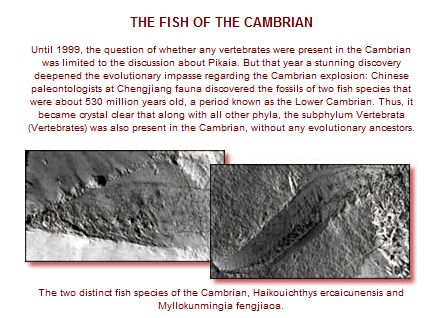As we said at the beginning, one of the phyla that suddenly emerged in the Cambrian Age is the Chordata, those creatures with a central nervous system contained within a braincase and a notochord or spinal column. Vertebrates are a subgroup of chordates. Vertebrates, divided into such fundamental classes as fish, amphibians, reptiles, birds, and mammals, are probably the most dominant creatures in the animal kingdom.
Because evolutionary paleontologists try to view every phylum as the evolutionary continuation of another phylum, they claim that the Chordata phylum evolved from another, invertebrate one. But the fact that, as with all phyla, the members of the Chordata emerged in the Cambrian Age invalidates this claim right from the very start. The oldest member of the Chordata phylum identified from the Cambrian Age is a sea-creature called Pikaia, which with its long body reminds one at first sight of a worm.75 Pikaia emerged at the same time as all the other species in the phylum which could be proposed as its ancestor, and with no intermediate forms between them. Professor Mustafa Kuru, a Turkish evolutionary biologist, says in his book Vertebrates:
There is no doubt that chordates evolved from invertebrates. However, the lack of transitional forms between invertebrates and chordates causes people to put forward many assumptions.76
If there is no transitional form between chordates and invertebrates, then how can one say "there is no doubt that chordates evolved from invertebrates?" Accepting an assumption which lacks supporting evidence, without entertaining any doubts, is surely not a scientific approach, but a dogmatic one. After this statement, Professor Kuru discusses the evolutionist assumptions regarding the origins of vertebrates, and once again confesses that the fossil record of chordates consists only of gaps:
The views stated above about the origins of chordates and evolution are always met with suspicion, since they are not based on any fossil records.77
Evolutionary biologists sometimes claim that the reason why there exist no fossil records regarding the origin of vertebrates is because invertebrates have soft tissues and consequently leave no fossil traces. However this explanation is entirely unrealistic, since there is an abundance of fossil remains of invertebrates in the fossil record. Nearly all organisms in the Cambrian period were invertebrates, and tens of thousands of fossil examples of these species have been collected. For example, there are many fossils of soft-tissued creatures in Canada's Burgess Shale beds. (Scientists think that invertebrates were fossilized, and their soft tissues kept intact in regions such as Burgess Shale, by being suddenly covered in mud with a very low oxygen content.78
The theory of evolution assumes that the first Chordata, such as Pikaia, evolved into fish. However, just as with the case of the supposed evolution of Chordata, the theory of the evolution of fish also lacks fossil evidence to support it. On the contrary, all distinct classes of fish emerged in the fossil record all of a sudden and fully-formed. There are millions of invertebrate fossils and millions of fish fossils; yet there is not even one fossil that is midway between them.
Robert Carroll admits the evolutionist impasse on the origin of several taxa among the early vertebrates:
We still have no evidence of the nature of the transition between cephalochordates and craniates. The earliest adequately known vertebrates already exhibit all the definitive features of craniates that we can expect to have preserved in fossils. No fossils are known that document the origin of jawed vertebrates.79
Another evolutionary paleontologist, Gerald T. Todd, admits a similar fact in an article titled "Evolution of the Lung and the Origin of Bony Fishes":
All three subdivisions of bony fishes first appear in the fossil record at approximately the same time. They are already widely divergent morphologically, and are heavily armored. How did they originate? What allowed them to diverge so widely? How did they all come to have heavy armor? And why is there no trace of earlier, intermediate forms?80
75 Douglas Palmer, The Atlas of the Prehistoric World, Discovery Channel, Marshall Publishing, London, 1999, p. 66. 76 Mustafa Kuru, Omurgali Hayvanlar (Vertebrates), Gazi University Publications, 5th ed., Ankara, 1996, p. 21. (emphasis added)
76 Mustafa Kuru, Omurgali Hayvanlar (Vertebrates), Gazi University Publications, 5th ed., Ankara, 1996, p. 21. (emphasis added) 77 Mustafa Kuru, Omurgali Hayvanlar (Vertebrates), Gazi University Publications, 5th ed., Ankara, 1996, p. 27.
77 Mustafa Kuru, Omurgali Hayvanlar (Vertebrates), Gazi University Publications, 5th ed., Ankara, 1996, p. 27. 78 Douglas Palmer, The Atlas of the Prehistoric World, Discovery Channel, Marshall Publishing, London, 1999, p. 64.
78 Douglas Palmer, The Atlas of the Prehistoric World, Discovery Channel, Marshall Publishing, London, 1999, p. 64.
79 Robert L. Carroll, Patterns and Processes of Vertebrate Evolution, Cambridge University Press, 1997, pp. 296.
80 Gerald T. Todd, "Evolution of the Lung and the Origin of Bony Fishes: A Casual Relationship," American Zoologist, vol. 26, no. 4, 1980, p. 757.
79 Robert L. Carroll, Patterns and Processes of Vertebrate Evolution, Cambridge University Press, 1997, pp. 296.
80 Gerald T. Todd, "Evolution of the Lung and the Origin of Bony Fishes: A Casual Relationship," American Zoologist, vol. 26, no. 4, 1980, p. 757.



No comments:
Post a Comment